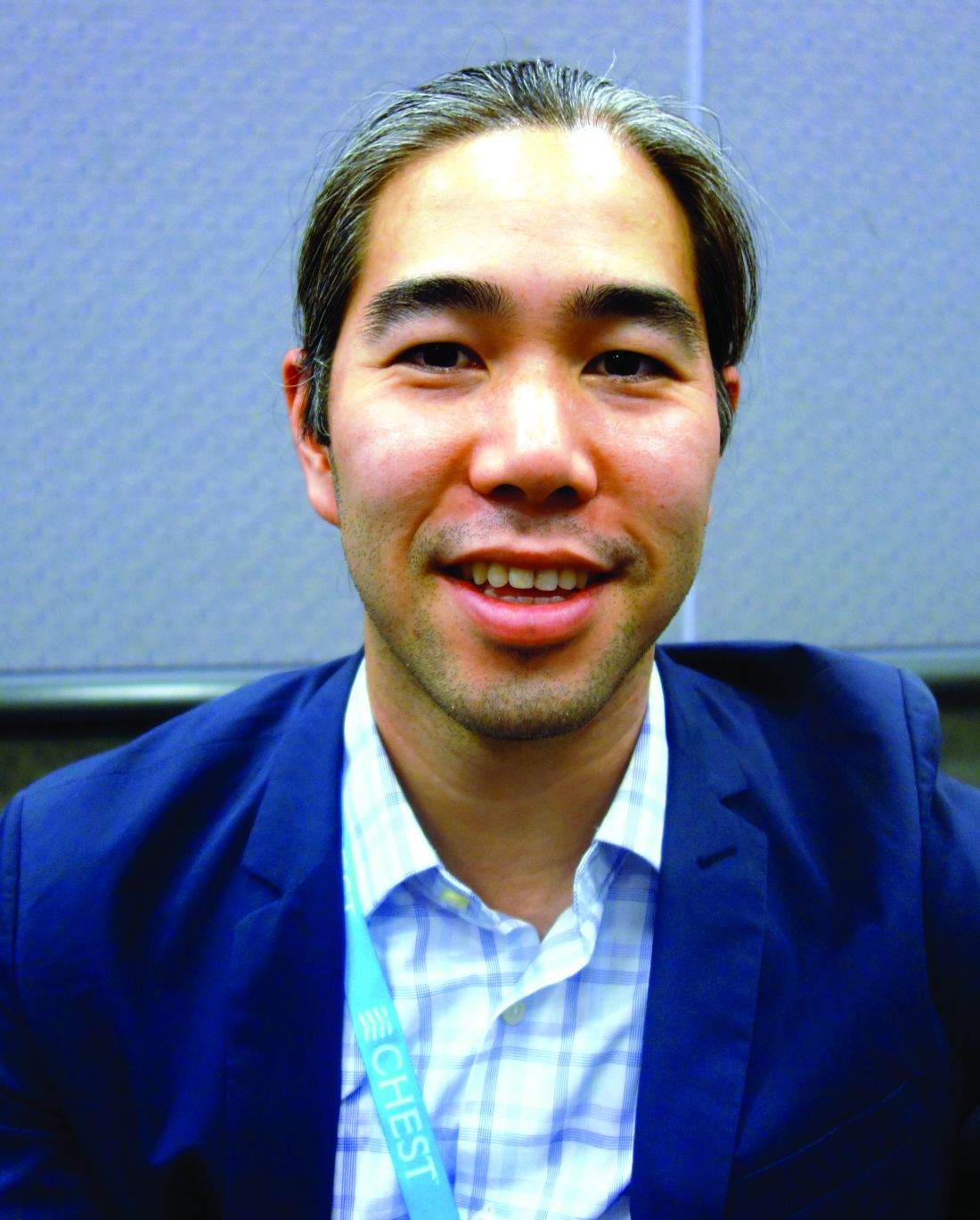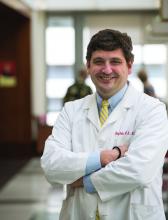User login
CDC: Seven cases of multidrug resistant C. auris have occurred in United States
The Centers for Disease Control and Prevention have reported the first cases of the multidrug-resistant fungal infection Candida auris in the United States, with evidence suggesting transmission may have occurred within U.S. health care facilities.
The report, published in the Nov. 4 edition of Morbidity and Mortality Weekly Report, described seven cases of patients infected with C. auris, which was isolated from blood in five cases, urine in one, and the ear in one. All the patients with bloodstream infections had central venous catheters at the time of diagnosis, and four of these patients died in the weeks and months after diagnosis of the infection.
Patients’ underlying conditions usually involved immune system suppression resulting from corticisteroid therapy, malignancty, short gut syndrome, or parapleglia with a long-term, indwelling Foley catheter.
C. auris was first isolated in 2009 in Japan, but has since been reported in countries including Colombia, India, South Africa, Israel, and the United Kingdom. Snigdha Vallabhaneni, MD, of the mycotic diseases branch of CDC’s division of food water and environmental diseases, and her coauthors, said its appearance in the United States is a cause for serious concern (MMWR. 2016 Nov 4. doi: 0.15585/mmwr.mm6544e1).
“First, many isolates are multidrug resistant, with some strains having elevated minimum inhibitory concentrations to drugs in all three major classes of antifungal medications, a feature not found in other clinically relevant Candida species,” the authors wrote. All the patients with bloodstream infections were treated with antifungal echinocandins, and one also received liposomal amphotericin B.
“Second, C. auris is challenging to identify, requiring specialized methods such as matrix-assisted laser desorption/ionization time-of-flight or molecular identification based on sequencing the D1-D2 region of the 28s ribosomal DNA.”
They also highlighted that C. auris is known to cause outbreaks in health care settings. Samples taken from the mattress, bedside table, bed rail, chair, and windowsill in the room of one patient all tested positive for C. auris.
The authors also sequenced the genome of the isolates and found that isolates taken from patients admitted to the same hospital in New Jersey or the same Illinois hospital were nearly identical.
“Facilities should ensure thorough daily and terminal cleaning of rooms of patients with C. auris infections, including use of an [Environmental Protection Agency]–registered disinfectant with a fungal claim,” the authors wrote, stressing that facilities and laboratories should continue to report cases and forward suspicious unidentified Candida isolates to state or local health authorities and the CDC.
No conflicts of interest were declared.
The Centers for Disease Control and Prevention have reported the first cases of the multidrug-resistant fungal infection Candida auris in the United States, with evidence suggesting transmission may have occurred within U.S. health care facilities.
The report, published in the Nov. 4 edition of Morbidity and Mortality Weekly Report, described seven cases of patients infected with C. auris, which was isolated from blood in five cases, urine in one, and the ear in one. All the patients with bloodstream infections had central venous catheters at the time of diagnosis, and four of these patients died in the weeks and months after diagnosis of the infection.
Patients’ underlying conditions usually involved immune system suppression resulting from corticisteroid therapy, malignancty, short gut syndrome, or parapleglia with a long-term, indwelling Foley catheter.
C. auris was first isolated in 2009 in Japan, but has since been reported in countries including Colombia, India, South Africa, Israel, and the United Kingdom. Snigdha Vallabhaneni, MD, of the mycotic diseases branch of CDC’s division of food water and environmental diseases, and her coauthors, said its appearance in the United States is a cause for serious concern (MMWR. 2016 Nov 4. doi: 0.15585/mmwr.mm6544e1).
“First, many isolates are multidrug resistant, with some strains having elevated minimum inhibitory concentrations to drugs in all three major classes of antifungal medications, a feature not found in other clinically relevant Candida species,” the authors wrote. All the patients with bloodstream infections were treated with antifungal echinocandins, and one also received liposomal amphotericin B.
“Second, C. auris is challenging to identify, requiring specialized methods such as matrix-assisted laser desorption/ionization time-of-flight or molecular identification based on sequencing the D1-D2 region of the 28s ribosomal DNA.”
They also highlighted that C. auris is known to cause outbreaks in health care settings. Samples taken from the mattress, bedside table, bed rail, chair, and windowsill in the room of one patient all tested positive for C. auris.
The authors also sequenced the genome of the isolates and found that isolates taken from patients admitted to the same hospital in New Jersey or the same Illinois hospital were nearly identical.
“Facilities should ensure thorough daily and terminal cleaning of rooms of patients with C. auris infections, including use of an [Environmental Protection Agency]–registered disinfectant with a fungal claim,” the authors wrote, stressing that facilities and laboratories should continue to report cases and forward suspicious unidentified Candida isolates to state or local health authorities and the CDC.
No conflicts of interest were declared.
The Centers for Disease Control and Prevention have reported the first cases of the multidrug-resistant fungal infection Candida auris in the United States, with evidence suggesting transmission may have occurred within U.S. health care facilities.
The report, published in the Nov. 4 edition of Morbidity and Mortality Weekly Report, described seven cases of patients infected with C. auris, which was isolated from blood in five cases, urine in one, and the ear in one. All the patients with bloodstream infections had central venous catheters at the time of diagnosis, and four of these patients died in the weeks and months after diagnosis of the infection.
Patients’ underlying conditions usually involved immune system suppression resulting from corticisteroid therapy, malignancty, short gut syndrome, or parapleglia with a long-term, indwelling Foley catheter.
C. auris was first isolated in 2009 in Japan, but has since been reported in countries including Colombia, India, South Africa, Israel, and the United Kingdom. Snigdha Vallabhaneni, MD, of the mycotic diseases branch of CDC’s division of food water and environmental diseases, and her coauthors, said its appearance in the United States is a cause for serious concern (MMWR. 2016 Nov 4. doi: 0.15585/mmwr.mm6544e1).
“First, many isolates are multidrug resistant, with some strains having elevated minimum inhibitory concentrations to drugs in all three major classes of antifungal medications, a feature not found in other clinically relevant Candida species,” the authors wrote. All the patients with bloodstream infections were treated with antifungal echinocandins, and one also received liposomal amphotericin B.
“Second, C. auris is challenging to identify, requiring specialized methods such as matrix-assisted laser desorption/ionization time-of-flight or molecular identification based on sequencing the D1-D2 region of the 28s ribosomal DNA.”
They also highlighted that C. auris is known to cause outbreaks in health care settings. Samples taken from the mattress, bedside table, bed rail, chair, and windowsill in the room of one patient all tested positive for C. auris.
The authors also sequenced the genome of the isolates and found that isolates taken from patients admitted to the same hospital in New Jersey or the same Illinois hospital were nearly identical.
“Facilities should ensure thorough daily and terminal cleaning of rooms of patients with C. auris infections, including use of an [Environmental Protection Agency]–registered disinfectant with a fungal claim,” the authors wrote, stressing that facilities and laboratories should continue to report cases and forward suspicious unidentified Candida isolates to state or local health authorities and the CDC.
No conflicts of interest were declared.
Key clinical point: The first cases of the multidrug-resistant fungal infection C. auris have been reported in the United States.
Major finding: Seven cases of infection with the multidrug-resistant emerging fungal infection C. auris have been reported in the United States, five of which were bloodstream infections.
Data source: Case series.
Disclosures: No conflicts of interest were declared.
Optimal MPE management requires early pulmonology referral
LOS ANGELES – About half of patients with symptomatic malignant pleural effusions at McGill University Health Centre in Montreal had unnecessary procedures and hospital admissions before definitive treatment with chemical pleurodesis or indwelling pleural catheters, according to researchers.
Instead of chest taps to relieve symptoms followed by referrals for definitive treatment, some patients got chest tubes – without pleurodesis – after presenting to the emergency department and being referred to radiology; they were then admitted to the hospital for a few days while the tubes were in place. In short, cancer patients were wasting what time they had left on medical care they didn’t need, and incurring unnecessary costs, said lead investigator Benjamin Shieh, MD, formerly at McGill but now an interventional pulmonology fellow at the University of Calgary.
McGill is a tertiary care center able to perform both definitive procedures, so “we should be a center of excellence. I imagine there are similar situations” at other hospitals, especially those without the resources of McGill, Dr. Shieh said at the annual meeting of the American College of Chest Physicians.
McGill has taken several steps to address the problem, including early ED referral to the pulmonology service and discouraging radiology from placing chest tubes for malignant pleural effusions (MPE). “I think we can avoid a big proportion of hospitalizations for MPE, and certainly a proportion of repeat [ED] visits,” said senior author Anne Gonzalez, MD, an attending pulmonologist at McGill.
The investigators looked into the issue after noting that a lot of their MPE cases had been hospitalized with chest tubes. They reviewed 72 symptomatic MPE cases in 69 patients treated in 2014 and 2015. Management was ideal in 36 cases (50%), meaning that, prior to definitive treatment, patients had no more than two pleural taps for symptom relief, no more than one ED visit, no chest tubes without pleurodesis, and no hospitalizations. “We thought this would be reasonable to try to achieve for MPE,” since there’s no definition of ideal management, Dr. Shieh said.
Nonideal patients had a mean of 2.5 pleural procedures – almost twice the number in the ideal group – before definitive palliation, with no respiratory consult beforehand. Chest tubes were placed in 27 cases (38%) for an average of 3.7 days; 28 cases (39%) were hospitalized. Nonideal patients were far more likely to present first to the ED, and ED presentations were more likely to get chest tubes and be admitted. All the cases were eventually treated definitively, 68 with indwelling pleural catheters and 4 by thoracoscopic talc insufflation. Time from initial presentation to definitive palliation was about 1 month in both groups. The investigators didn’t consider rate of effusion recurrence, which might help explain why the ideal group wasn’t treated sooner; they might not have needed it. The higher number of ED visits in the nonideal group suggests that they may have had quicker recurrences, and should have been treated sooner, Dr. Gonzalez said.
The patients were 70 years old, on average, and about 60% were women. Lung and breast were the most common cancers.
There was no industry funding for the work, and the investigators had no disclosures.
LOS ANGELES – About half of patients with symptomatic malignant pleural effusions at McGill University Health Centre in Montreal had unnecessary procedures and hospital admissions before definitive treatment with chemical pleurodesis or indwelling pleural catheters, according to researchers.
Instead of chest taps to relieve symptoms followed by referrals for definitive treatment, some patients got chest tubes – without pleurodesis – after presenting to the emergency department and being referred to radiology; they were then admitted to the hospital for a few days while the tubes were in place. In short, cancer patients were wasting what time they had left on medical care they didn’t need, and incurring unnecessary costs, said lead investigator Benjamin Shieh, MD, formerly at McGill but now an interventional pulmonology fellow at the University of Calgary.
McGill is a tertiary care center able to perform both definitive procedures, so “we should be a center of excellence. I imagine there are similar situations” at other hospitals, especially those without the resources of McGill, Dr. Shieh said at the annual meeting of the American College of Chest Physicians.
McGill has taken several steps to address the problem, including early ED referral to the pulmonology service and discouraging radiology from placing chest tubes for malignant pleural effusions (MPE). “I think we can avoid a big proportion of hospitalizations for MPE, and certainly a proportion of repeat [ED] visits,” said senior author Anne Gonzalez, MD, an attending pulmonologist at McGill.
The investigators looked into the issue after noting that a lot of their MPE cases had been hospitalized with chest tubes. They reviewed 72 symptomatic MPE cases in 69 patients treated in 2014 and 2015. Management was ideal in 36 cases (50%), meaning that, prior to definitive treatment, patients had no more than two pleural taps for symptom relief, no more than one ED visit, no chest tubes without pleurodesis, and no hospitalizations. “We thought this would be reasonable to try to achieve for MPE,” since there’s no definition of ideal management, Dr. Shieh said.
Nonideal patients had a mean of 2.5 pleural procedures – almost twice the number in the ideal group – before definitive palliation, with no respiratory consult beforehand. Chest tubes were placed in 27 cases (38%) for an average of 3.7 days; 28 cases (39%) were hospitalized. Nonideal patients were far more likely to present first to the ED, and ED presentations were more likely to get chest tubes and be admitted. All the cases were eventually treated definitively, 68 with indwelling pleural catheters and 4 by thoracoscopic talc insufflation. Time from initial presentation to definitive palliation was about 1 month in both groups. The investigators didn’t consider rate of effusion recurrence, which might help explain why the ideal group wasn’t treated sooner; they might not have needed it. The higher number of ED visits in the nonideal group suggests that they may have had quicker recurrences, and should have been treated sooner, Dr. Gonzalez said.
The patients were 70 years old, on average, and about 60% were women. Lung and breast were the most common cancers.
There was no industry funding for the work, and the investigators had no disclosures.
LOS ANGELES – About half of patients with symptomatic malignant pleural effusions at McGill University Health Centre in Montreal had unnecessary procedures and hospital admissions before definitive treatment with chemical pleurodesis or indwelling pleural catheters, according to researchers.
Instead of chest taps to relieve symptoms followed by referrals for definitive treatment, some patients got chest tubes – without pleurodesis – after presenting to the emergency department and being referred to radiology; they were then admitted to the hospital for a few days while the tubes were in place. In short, cancer patients were wasting what time they had left on medical care they didn’t need, and incurring unnecessary costs, said lead investigator Benjamin Shieh, MD, formerly at McGill but now an interventional pulmonology fellow at the University of Calgary.
McGill is a tertiary care center able to perform both definitive procedures, so “we should be a center of excellence. I imagine there are similar situations” at other hospitals, especially those without the resources of McGill, Dr. Shieh said at the annual meeting of the American College of Chest Physicians.
McGill has taken several steps to address the problem, including early ED referral to the pulmonology service and discouraging radiology from placing chest tubes for malignant pleural effusions (MPE). “I think we can avoid a big proportion of hospitalizations for MPE, and certainly a proportion of repeat [ED] visits,” said senior author Anne Gonzalez, MD, an attending pulmonologist at McGill.
The investigators looked into the issue after noting that a lot of their MPE cases had been hospitalized with chest tubes. They reviewed 72 symptomatic MPE cases in 69 patients treated in 2014 and 2015. Management was ideal in 36 cases (50%), meaning that, prior to definitive treatment, patients had no more than two pleural taps for symptom relief, no more than one ED visit, no chest tubes without pleurodesis, and no hospitalizations. “We thought this would be reasonable to try to achieve for MPE,” since there’s no definition of ideal management, Dr. Shieh said.
Nonideal patients had a mean of 2.5 pleural procedures – almost twice the number in the ideal group – before definitive palliation, with no respiratory consult beforehand. Chest tubes were placed in 27 cases (38%) for an average of 3.7 days; 28 cases (39%) were hospitalized. Nonideal patients were far more likely to present first to the ED, and ED presentations were more likely to get chest tubes and be admitted. All the cases were eventually treated definitively, 68 with indwelling pleural catheters and 4 by thoracoscopic talc insufflation. Time from initial presentation to definitive palliation was about 1 month in both groups. The investigators didn’t consider rate of effusion recurrence, which might help explain why the ideal group wasn’t treated sooner; they might not have needed it. The higher number of ED visits in the nonideal group suggests that they may have had quicker recurrences, and should have been treated sooner, Dr. Gonzalez said.
The patients were 70 years old, on average, and about 60% were women. Lung and breast were the most common cancers.
There was no industry funding for the work, and the investigators had no disclosures.
AT CHEST 2016
Key clinical point:
Major finding: Those patients had a mean of 2.5 pleural procedures before definitive palliation, with no respiratory consult beforehand. Chest tubes were placed for an average of 3.7 days.
Data source: Review of 72 MPE cases in 69 patients.
Disclosures: There was no industry funding for the work, and the investigators had no disclosures.
Lessons learned from using CDK 4/6 inhibitors to treat metastatic breast cancer
45 new cancer drugs – a significant jump from the average 26 approvals annually from 2006 to 2014. This major shift in the number of approvals is due to many factors, including the intensified efforts by scientists and clinicians to develop new drugs, especially novel immunotherapies, and changes in the FDA’s drug approval process under the leadership of Dr Richard Pazdur.
Click on the PDF icon at the top of this introduction to read the full article.
45 new cancer drugs – a significant jump from the average 26 approvals annually from 2006 to 2014. This major shift in the number of approvals is due to many factors, including the intensified efforts by scientists and clinicians to develop new drugs, especially novel immunotherapies, and changes in the FDA’s drug approval process under the leadership of Dr Richard Pazdur.
Click on the PDF icon at the top of this introduction to read the full article.
45 new cancer drugs – a significant jump from the average 26 approvals annually from 2006 to 2014. This major shift in the number of approvals is due to many factors, including the intensified efforts by scientists and clinicians to develop new drugs, especially novel immunotherapies, and changes in the FDA’s drug approval process under the leadership of Dr Richard Pazdur.
Click on the PDF icon at the top of this introduction to read the full article.
Home-based intervention improves cognitive impairment in cancer survivors
A home-based intervention designed to address cognitive impairment in cancer survivors led to significant improvements in perceived cognitive impairment, anxiety, stress, and quality of life, compared with usual care.
The intervention, a computerized neurocognitive learning program, “targets cognitive domains including visual precision, divided attention, working memory, field of view, and visual processing speed, which are frequently affected in patients with cancer,” wrote Victoria J. Bray, MD, of the University of Sydney, and coauthors.
Investigators evaluated the program in a randomized controlled trial of 242 adult cancer survivors. The majority were female (95%) and had been treated for breast cancer (89%). The mean time since completion of chemotherapy was 27 months (6-60 months).
The program used, Insight From Posit Science, involved four 40-minute sessions a week for 15 weeks.
At the end of the 15-week intervention, the 121 patients in the intervention group showed significantly less perceived cognitive impairment, according to the Functional Assessment of Cancer Therapy Cognitive Function questionnaire, than the 121 patients in the standard care control group. This improvement persisted at the 6-month follow-up (J Clin Oncol. 2016 Oct 31. doi: 10.1200/JCO.2016.67.8201).
Participants in the intervention group also reported significantly better perceived cognitive abilities, and significantly less impact on their quality of life from cognitive impairment. They also reported having fewer comments from others on their cognitive impairment after the intervention finished, although this difference between the two groups disappeared by 6 months.
The authors saw no significant differences between the two groups in neuropsychological function during the follow-up; however, they stressed this result should be interpreted with caution because of missing data at both the 15-week and 6-month follow-up.
The intervention was also associated with significantly less anxiety, depression,and fatigue at the end of the 15-week period but not at the 6-month follow-up. Participants did show significant improvements in perceived stress at both follow-up points, compared with those in the control group.
Overall, only 27% of participants finished the program in the recommended 15-week time frame, and 14% never started the program.
The authors said there was a large unmet need for effective treatment options for cancer survivors experiencing cognitive symptoms after cancer treatment, even though previous research had suggested that cognitive rehabilitation strategies were feasible.
“Our large RCT [randomized controlled trial] adds weight to this evidence, confirming that the use of Insight led to an improvement in cognitive symptoms,” they wrote, pointing out the advantage of this relatively inexpensive, home-based treatment approach. “The program has the potential to provide a new treatment option for patients with cancer with cognitive symptoms, where previously none existed.”
A home-based intervention designed to address cognitive impairment in cancer survivors led to significant improvements in perceived cognitive impairment, anxiety, stress, and quality of life, compared with usual care.
The intervention, a computerized neurocognitive learning program, “targets cognitive domains including visual precision, divided attention, working memory, field of view, and visual processing speed, which are frequently affected in patients with cancer,” wrote Victoria J. Bray, MD, of the University of Sydney, and coauthors.
Investigators evaluated the program in a randomized controlled trial of 242 adult cancer survivors. The majority were female (95%) and had been treated for breast cancer (89%). The mean time since completion of chemotherapy was 27 months (6-60 months).
The program used, Insight From Posit Science, involved four 40-minute sessions a week for 15 weeks.
At the end of the 15-week intervention, the 121 patients in the intervention group showed significantly less perceived cognitive impairment, according to the Functional Assessment of Cancer Therapy Cognitive Function questionnaire, than the 121 patients in the standard care control group. This improvement persisted at the 6-month follow-up (J Clin Oncol. 2016 Oct 31. doi: 10.1200/JCO.2016.67.8201).
Participants in the intervention group also reported significantly better perceived cognitive abilities, and significantly less impact on their quality of life from cognitive impairment. They also reported having fewer comments from others on their cognitive impairment after the intervention finished, although this difference between the two groups disappeared by 6 months.
The authors saw no significant differences between the two groups in neuropsychological function during the follow-up; however, they stressed this result should be interpreted with caution because of missing data at both the 15-week and 6-month follow-up.
The intervention was also associated with significantly less anxiety, depression,and fatigue at the end of the 15-week period but not at the 6-month follow-up. Participants did show significant improvements in perceived stress at both follow-up points, compared with those in the control group.
Overall, only 27% of participants finished the program in the recommended 15-week time frame, and 14% never started the program.
The authors said there was a large unmet need for effective treatment options for cancer survivors experiencing cognitive symptoms after cancer treatment, even though previous research had suggested that cognitive rehabilitation strategies were feasible.
“Our large RCT [randomized controlled trial] adds weight to this evidence, confirming that the use of Insight led to an improvement in cognitive symptoms,” they wrote, pointing out the advantage of this relatively inexpensive, home-based treatment approach. “The program has the potential to provide a new treatment option for patients with cancer with cognitive symptoms, where previously none existed.”
A home-based intervention designed to address cognitive impairment in cancer survivors led to significant improvements in perceived cognitive impairment, anxiety, stress, and quality of life, compared with usual care.
The intervention, a computerized neurocognitive learning program, “targets cognitive domains including visual precision, divided attention, working memory, field of view, and visual processing speed, which are frequently affected in patients with cancer,” wrote Victoria J. Bray, MD, of the University of Sydney, and coauthors.
Investigators evaluated the program in a randomized controlled trial of 242 adult cancer survivors. The majority were female (95%) and had been treated for breast cancer (89%). The mean time since completion of chemotherapy was 27 months (6-60 months).
The program used, Insight From Posit Science, involved four 40-minute sessions a week for 15 weeks.
At the end of the 15-week intervention, the 121 patients in the intervention group showed significantly less perceived cognitive impairment, according to the Functional Assessment of Cancer Therapy Cognitive Function questionnaire, than the 121 patients in the standard care control group. This improvement persisted at the 6-month follow-up (J Clin Oncol. 2016 Oct 31. doi: 10.1200/JCO.2016.67.8201).
Participants in the intervention group also reported significantly better perceived cognitive abilities, and significantly less impact on their quality of life from cognitive impairment. They also reported having fewer comments from others on their cognitive impairment after the intervention finished, although this difference between the two groups disappeared by 6 months.
The authors saw no significant differences between the two groups in neuropsychological function during the follow-up; however, they stressed this result should be interpreted with caution because of missing data at both the 15-week and 6-month follow-up.
The intervention was also associated with significantly less anxiety, depression,and fatigue at the end of the 15-week period but not at the 6-month follow-up. Participants did show significant improvements in perceived stress at both follow-up points, compared with those in the control group.
Overall, only 27% of participants finished the program in the recommended 15-week time frame, and 14% never started the program.
The authors said there was a large unmet need for effective treatment options for cancer survivors experiencing cognitive symptoms after cancer treatment, even though previous research had suggested that cognitive rehabilitation strategies were feasible.
“Our large RCT [randomized controlled trial] adds weight to this evidence, confirming that the use of Insight led to an improvement in cognitive symptoms,” they wrote, pointing out the advantage of this relatively inexpensive, home-based treatment approach. “The program has the potential to provide a new treatment option for patients with cancer with cognitive symptoms, where previously none existed.”
FROM JOURNAL OF CLINICAL ONCOLOGY
Key clinical point: A home-based intervention for cancer survivors can improve perceived cognitive impairment, anxiety, stress, and quality of life.
Major finding: Patients who undertook a home-based cognitive impairment intervention for cancer survivors showed significantly lower scores for perceived cognitive impairment, compared with those in the standard care control group.
Data source: A randomized controlled trial in 242 adult cancer survivors.
Disclosures: The study was supported by the Cancer Council New South Wales, Friends of the Mater Foundation, the Clinical Oncology Society of Australia/ Roche Hematology Oncology Targeted Therapies Fellowship, a Pfizer Cancer Research Grant, and the National Breast Cancer Foundation. Three authors declared consultancies, travel support, and research funding from the pharmaceutical industry.
ASCO: Patients with advanced cancer should receive palliative care within 8 weeks of diagnosis
Patients with advanced cancer should receive dedicated palliative care services early in the disease course, concurrently with active treatment, according to the American Society of Clinical Oncology’s new guidelines on the integration of palliative care into standard oncology care.
Ideally, patients should be referred to interdisciplinary palliative care teams within 8 weeks of cancer diagnosis, and palliative care should be available in both the inpatient and outpatient setting, recommended ASCO.
The guidelines, which updated and expanded the 2012 ASCO provisional clinical opinion, were developed by a multidisciplinary expert panel that systematically reviewed phase III randomized controlled trials, secondary analyses of those trials, and meta-analyses that were published between March 2010 and January 2016.
According to the panel, essential components of palliative care include:
• Rapport and relationship building with patient and family caregivers.
• Symptom, distress, and functional status management.
• Exploration of understanding and education about illness and prognosis.
• Clarification of treatment goals.
• Assessment and support of coping needs.
• Assistance with medical decision making.
• Provision of referrals to other care providers as indicated.
The panel makes the case that not only does palliative care improve care for patients and families, it also likely reduces the total cost of care, often substantially. However, “race, poverty and low socioeconomic and/or immigration status are determinants of barriers to palliative care,” wrote the expert panel, which was cochaired by Betty Ferrell, PhD, of the City of Hope Medical Center, Duarte, Calif., and Thomas Smith, MD, of the Sidney Kimmel Comprehensive Cancer Center in Baltimore.
Read the full guidelines here.
[email protected]
On Twitter @jessnicolecraig
Patients with advanced cancer should receive dedicated palliative care services early in the disease course, concurrently with active treatment, according to the American Society of Clinical Oncology’s new guidelines on the integration of palliative care into standard oncology care.
Ideally, patients should be referred to interdisciplinary palliative care teams within 8 weeks of cancer diagnosis, and palliative care should be available in both the inpatient and outpatient setting, recommended ASCO.
The guidelines, which updated and expanded the 2012 ASCO provisional clinical opinion, were developed by a multidisciplinary expert panel that systematically reviewed phase III randomized controlled trials, secondary analyses of those trials, and meta-analyses that were published between March 2010 and January 2016.
According to the panel, essential components of palliative care include:
• Rapport and relationship building with patient and family caregivers.
• Symptom, distress, and functional status management.
• Exploration of understanding and education about illness and prognosis.
• Clarification of treatment goals.
• Assessment and support of coping needs.
• Assistance with medical decision making.
• Provision of referrals to other care providers as indicated.
The panel makes the case that not only does palliative care improve care for patients and families, it also likely reduces the total cost of care, often substantially. However, “race, poverty and low socioeconomic and/or immigration status are determinants of barriers to palliative care,” wrote the expert panel, which was cochaired by Betty Ferrell, PhD, of the City of Hope Medical Center, Duarte, Calif., and Thomas Smith, MD, of the Sidney Kimmel Comprehensive Cancer Center in Baltimore.
Read the full guidelines here.
[email protected]
On Twitter @jessnicolecraig
Patients with advanced cancer should receive dedicated palliative care services early in the disease course, concurrently with active treatment, according to the American Society of Clinical Oncology’s new guidelines on the integration of palliative care into standard oncology care.
Ideally, patients should be referred to interdisciplinary palliative care teams within 8 weeks of cancer diagnosis, and palliative care should be available in both the inpatient and outpatient setting, recommended ASCO.
The guidelines, which updated and expanded the 2012 ASCO provisional clinical opinion, were developed by a multidisciplinary expert panel that systematically reviewed phase III randomized controlled trials, secondary analyses of those trials, and meta-analyses that were published between March 2010 and January 2016.
According to the panel, essential components of palliative care include:
• Rapport and relationship building with patient and family caregivers.
• Symptom, distress, and functional status management.
• Exploration of understanding and education about illness and prognosis.
• Clarification of treatment goals.
• Assessment and support of coping needs.
• Assistance with medical decision making.
• Provision of referrals to other care providers as indicated.
The panel makes the case that not only does palliative care improve care for patients and families, it also likely reduces the total cost of care, often substantially. However, “race, poverty and low socioeconomic and/or immigration status are determinants of barriers to palliative care,” wrote the expert panel, which was cochaired by Betty Ferrell, PhD, of the City of Hope Medical Center, Duarte, Calif., and Thomas Smith, MD, of the Sidney Kimmel Comprehensive Cancer Center in Baltimore.
Read the full guidelines here.
[email protected]
On Twitter @jessnicolecraig
FROM THE JOURNAL OF CLINICAL ONCOLOGY
Cancer survivors report two times greater medication use for anxiety and depression
Approximately 20% of adult cancer survivors in the United States – roughly 2.5 million – take medication for anxiety or depression, a rate that is approximately twice that of the general population, according to a report published online in Journal of Clinical Oncology.
Considering that previous research reported that more than 30% of cancer survivors discuss psychosocial concerns with their medical providers, this finding suggests that “even more survivors might benefit from pharmacologic treatment than were receiving treatment at the time of this study,” said Nikki A. Hawkins, PhD, of the Centers for Disease Control and Prevention, and her associates.
“If left unaddressed and untreated, anxiety and depression have been found to negatively affect health behaviors, the body’s inflammatory response, and even survival.” Yet rates of medication use have not been examined until now, the investigators noted.
Dr. Hawkins and her associates analyzed data from the National Health Interview Surveys for 2010 through 2013 to determine population-based prevalence rates. Their study population comprised a nationally representative sample of 48,181 adults, of whom 3,184 were cancer survivors.
Compared with the general population, cancer survivors were approximately twice as likely to self-report taking medication for anxiety (16.8% vs 8.6%), depression (14.1% vs 7.8%), both conditions (11.8% vs 6.1%), and one or both conditions combined (19.1% vs 10.3%). When these results were extrapolated to the entire country, an estimated 2.5 million cancer survivors were found to currently use these medications, the investigators reported (J Clin Oncol. 2016 Oct 26. doi: 10.1200/JCO.2016.67.7690).
“Interestingly, medication use did not vary significantly by time since cancer diagnosis, which is consistent with recent research that has shown elevated rates of depression and mental disorders for cancer survivors as much as 10 years after diagnosis,” they wrote.
The highest rates (greater than 20%) of antianxiety and antidepressant use occurred among patients who were middle aged (those aged 40-64 years), had never married, had three or more chronic health conditions, expected to have a short survival time, or had ovarian or uterine cancer.
Nine types of cancer were included in this study: breast, prostate, melanoma, cervical, colorectal, hematologic, ovarian/uterine, “short survival,” and other. Of these, patients with prostate cancer were the least likely to use antianxiety or antidepressant medications, and patients with ovarian/uterine and short survival cancers were the most likely to.
“Efforts to improve the psychosocial care of cancer survivors will be aided by continued tracking of the treatment received for mental health. Good medical care requires systematic evaluation, screening for new problems, and making adjustments to the prescribed therapies as needed, and survivors’ mental health deserves the same detailed, evidence-based, and ongoing attention,” Dr. Hawkins and her associates said.
This study was supported by the Centers for Disease Control and Prevention. Dr. Hawkins and her associates reported having no relevant financial disclosures.
Approximately 20% of adult cancer survivors in the United States – roughly 2.5 million – take medication for anxiety or depression, a rate that is approximately twice that of the general population, according to a report published online in Journal of Clinical Oncology.
Considering that previous research reported that more than 30% of cancer survivors discuss psychosocial concerns with their medical providers, this finding suggests that “even more survivors might benefit from pharmacologic treatment than were receiving treatment at the time of this study,” said Nikki A. Hawkins, PhD, of the Centers for Disease Control and Prevention, and her associates.
“If left unaddressed and untreated, anxiety and depression have been found to negatively affect health behaviors, the body’s inflammatory response, and even survival.” Yet rates of medication use have not been examined until now, the investigators noted.
Dr. Hawkins and her associates analyzed data from the National Health Interview Surveys for 2010 through 2013 to determine population-based prevalence rates. Their study population comprised a nationally representative sample of 48,181 adults, of whom 3,184 were cancer survivors.
Compared with the general population, cancer survivors were approximately twice as likely to self-report taking medication for anxiety (16.8% vs 8.6%), depression (14.1% vs 7.8%), both conditions (11.8% vs 6.1%), and one or both conditions combined (19.1% vs 10.3%). When these results were extrapolated to the entire country, an estimated 2.5 million cancer survivors were found to currently use these medications, the investigators reported (J Clin Oncol. 2016 Oct 26. doi: 10.1200/JCO.2016.67.7690).
“Interestingly, medication use did not vary significantly by time since cancer diagnosis, which is consistent with recent research that has shown elevated rates of depression and mental disorders for cancer survivors as much as 10 years after diagnosis,” they wrote.
The highest rates (greater than 20%) of antianxiety and antidepressant use occurred among patients who were middle aged (those aged 40-64 years), had never married, had three or more chronic health conditions, expected to have a short survival time, or had ovarian or uterine cancer.
Nine types of cancer were included in this study: breast, prostate, melanoma, cervical, colorectal, hematologic, ovarian/uterine, “short survival,” and other. Of these, patients with prostate cancer were the least likely to use antianxiety or antidepressant medications, and patients with ovarian/uterine and short survival cancers were the most likely to.
“Efforts to improve the psychosocial care of cancer survivors will be aided by continued tracking of the treatment received for mental health. Good medical care requires systematic evaluation, screening for new problems, and making adjustments to the prescribed therapies as needed, and survivors’ mental health deserves the same detailed, evidence-based, and ongoing attention,” Dr. Hawkins and her associates said.
This study was supported by the Centers for Disease Control and Prevention. Dr. Hawkins and her associates reported having no relevant financial disclosures.
Approximately 20% of adult cancer survivors in the United States – roughly 2.5 million – take medication for anxiety or depression, a rate that is approximately twice that of the general population, according to a report published online in Journal of Clinical Oncology.
Considering that previous research reported that more than 30% of cancer survivors discuss psychosocial concerns with their medical providers, this finding suggests that “even more survivors might benefit from pharmacologic treatment than were receiving treatment at the time of this study,” said Nikki A. Hawkins, PhD, of the Centers for Disease Control and Prevention, and her associates.
“If left unaddressed and untreated, anxiety and depression have been found to negatively affect health behaviors, the body’s inflammatory response, and even survival.” Yet rates of medication use have not been examined until now, the investigators noted.
Dr. Hawkins and her associates analyzed data from the National Health Interview Surveys for 2010 through 2013 to determine population-based prevalence rates. Their study population comprised a nationally representative sample of 48,181 adults, of whom 3,184 were cancer survivors.
Compared with the general population, cancer survivors were approximately twice as likely to self-report taking medication for anxiety (16.8% vs 8.6%), depression (14.1% vs 7.8%), both conditions (11.8% vs 6.1%), and one or both conditions combined (19.1% vs 10.3%). When these results were extrapolated to the entire country, an estimated 2.5 million cancer survivors were found to currently use these medications, the investigators reported (J Clin Oncol. 2016 Oct 26. doi: 10.1200/JCO.2016.67.7690).
“Interestingly, medication use did not vary significantly by time since cancer diagnosis, which is consistent with recent research that has shown elevated rates of depression and mental disorders for cancer survivors as much as 10 years after diagnosis,” they wrote.
The highest rates (greater than 20%) of antianxiety and antidepressant use occurred among patients who were middle aged (those aged 40-64 years), had never married, had three or more chronic health conditions, expected to have a short survival time, or had ovarian or uterine cancer.
Nine types of cancer were included in this study: breast, prostate, melanoma, cervical, colorectal, hematologic, ovarian/uterine, “short survival,” and other. Of these, patients with prostate cancer were the least likely to use antianxiety or antidepressant medications, and patients with ovarian/uterine and short survival cancers were the most likely to.
“Efforts to improve the psychosocial care of cancer survivors will be aided by continued tracking of the treatment received for mental health. Good medical care requires systematic evaluation, screening for new problems, and making adjustments to the prescribed therapies as needed, and survivors’ mental health deserves the same detailed, evidence-based, and ongoing attention,” Dr. Hawkins and her associates said.
This study was supported by the Centers for Disease Control and Prevention. Dr. Hawkins and her associates reported having no relevant financial disclosures.
Key clinical point: Cancer survivors take medications for anxiety and depression at approximately double the rate in the general population.
Major finding: Compared with the general population, cancer survivors were approximately twice as likely to self-report taking medication for anxiety (16.8% vs 8.6%), depression (14.1% vs 7.8%), both conditions (11.8% vs 6.1%), and one or both conditions combined (19.1% vs 10.3%).
Data source: A cross-sectional analysis of data from nationwide surveys of 48,181 adults, including 3,184 cancer survivors, during a 4-year period.
Disclosures: This study was supported by the Centers for Disease Control and Prevention. Dr. Hawkins and her associates reported having no relevant financial disclosures.
Change in end-of-life cancer care imperative
With the passage of the Medicare Access and CHIP Reauthorization Act, changes to how cancer care is delivered are fast approaching. This legislation aims to reward value-based care and incentivize alternative payment models that prize quality. The shift from quantity-based to value-based reimbursement is motivated in part by the rising cost of health care as well as the growing demand from patients, employers, and payers to better understand the quality of care being delivered. In cancer care, one area of high-cost and questionable value being examined is aggressive care at the end of life.
The scientific pace of progress in cancer care is exciting, with 19 therapies approved or granted a new indication in 2015. New categories of drugs, such as immunotherapies, are changing how we treat patients. It is also a time of great change in how cancer care is being delivered in our clinics, hospitals, and academic institutions. We must be vigilant in learning from these experiments in care delivery to ensure that they deliver on their promise of value to patients.
Dr. Bobby Daly, Dr. Andrew Hantel, and Dr. Blase Polite are with the University of Chicago.
With the passage of the Medicare Access and CHIP Reauthorization Act, changes to how cancer care is delivered are fast approaching. This legislation aims to reward value-based care and incentivize alternative payment models that prize quality. The shift from quantity-based to value-based reimbursement is motivated in part by the rising cost of health care as well as the growing demand from patients, employers, and payers to better understand the quality of care being delivered. In cancer care, one area of high-cost and questionable value being examined is aggressive care at the end of life.
The scientific pace of progress in cancer care is exciting, with 19 therapies approved or granted a new indication in 2015. New categories of drugs, such as immunotherapies, are changing how we treat patients. It is also a time of great change in how cancer care is being delivered in our clinics, hospitals, and academic institutions. We must be vigilant in learning from these experiments in care delivery to ensure that they deliver on their promise of value to patients.
Dr. Bobby Daly, Dr. Andrew Hantel, and Dr. Blase Polite are with the University of Chicago.
With the passage of the Medicare Access and CHIP Reauthorization Act, changes to how cancer care is delivered are fast approaching. This legislation aims to reward value-based care and incentivize alternative payment models that prize quality. The shift from quantity-based to value-based reimbursement is motivated in part by the rising cost of health care as well as the growing demand from patients, employers, and payers to better understand the quality of care being delivered. In cancer care, one area of high-cost and questionable value being examined is aggressive care at the end of life.
The scientific pace of progress in cancer care is exciting, with 19 therapies approved or granted a new indication in 2015. New categories of drugs, such as immunotherapies, are changing how we treat patients. It is also a time of great change in how cancer care is being delivered in our clinics, hospitals, and academic institutions. We must be vigilant in learning from these experiments in care delivery to ensure that they deliver on their promise of value to patients.
Dr. Bobby Daly, Dr. Andrew Hantel, and Dr. Blase Polite are with the University of Chicago.
Almost half of terminal cancer patient hospitalizations deemed avoidable
Nearly half of all intensive care unit hospitalizations among terminal oncology patients in a retrospective case review were identified as potentially avoidable.
The findings suggest a need for strategies to prospectively identify patients at risk for ICU admission and to formulate interventions to improve end-of-life care, wrote Bobby Daly, MD, and colleagues at the University of Chicago. The report was published in the Journal of Oncology Practice.
Of 72 terminal oncology patients who received care in a 600-bed academic medical center’s ambulatory oncology practice and died in an ICU between July 1, 2012, and June 30, 2013, within a week of transfer, 72% were men, 71% had solid tumor malignancies, and 51% had poor performance status (score of 2 or greater). The majority had multiple encounters with the health care system, but only 25% had a documented advance directive, the investigators found.
During a median ICU length of stay of 4 days, 82% of patients had a central line, 81% were intubated, 44% received a feeding tube, 39% received cardiopulmonary resuscitation, 22% began hemodialysis, and 8% received chemotherapy, while 6% had an inpatient palliative care consult, the researchers noted.
Notably, 47% of the ICU hospitalizations were determined to be potentially avoidable by at least two of three reviewers – an oncologist, an intensivist, and a hospitalist – and agreement between the reviewers was fair (kappa statistic, 0.24). Factors independently associated with avoidable hospitalizations on multivariable analysis were worse performance status prior to admission (median score, 2 vs. 1), worse Charlson comorbidity score (median, 8.5 vs. 7.0), number of hospitalizations in the previous 12 months (median, 2 vs. 1), and fewer days since the last outpatient oncology clinic visit (median 21 vs. 41 days). Having chemotherapy as the most recent treatment and cancer symptoms as the reason for hospitalization were also associated with potentially avoidable hospitalization (J Oncol Pract. 2016 Sep. doi: 10.1200/jop.2016.012823).
The findings are important because part of the reason for the increasing cost of cancer care in the United States, which is projected to increase by 27% over 2010 costs to $158 billion by 2020, is the increasingly aggressive care provided at the end of life, the investigators noted.
“Critically ill patients with cancer constitute a large percentage of ICU admissions, 25% of Medicare cancer beneficiaries receive ICU care in the last month of life, and 8% of patients with cancer die there,” they wrote.
Further, high-intensity end-of-life care has been shown in prior studies to improve neither survival nor quality of life for cancer patients.
In fact, the National Quality Forum “endorses ICU admissions in the last 30 days of life as a marker of poor-quality cancer care,” and other groups consider the proportion of patients with advanced cancer dying in the ICU as a quality-of-care metric, they said.
The current study was designed to explore the characteristics of oncology patients who expire in the ICU and the potential avoidability of their deaths there, and although the findings are limited by the single-center retrospective design and use of “subjective majority-driven medical record review,” they “serve to highlight terminal ICU hospitalization as an area of focus to improve the quality and value of cancer care,” the researchers wrote.
The findings also underscore the need for improved advance care planning, they added.
“Beyond the issues of cost and resource scarcity, these ICU deaths often create a traumatic experience for patients and families,” they wrote.
“Understanding these hospitalizations will contribute to the design of interventions aimed at avoiding unnecessary aggressive end-of-life care.”
Dr. Daly reported a leadership role with Quadrant Holdings and financial relationships with Quadrant Holdings, CVS Health, Johnson & Johnson, McKesson, and Walgreens Boots Alliance. Detailed disclosures for all authors are available with the full text of the article at jop.ascopubs.org.
Nearly half of all intensive care unit hospitalizations among terminal oncology patients in a retrospective case review were identified as potentially avoidable.
The findings suggest a need for strategies to prospectively identify patients at risk for ICU admission and to formulate interventions to improve end-of-life care, wrote Bobby Daly, MD, and colleagues at the University of Chicago. The report was published in the Journal of Oncology Practice.
Of 72 terminal oncology patients who received care in a 600-bed academic medical center’s ambulatory oncology practice and died in an ICU between July 1, 2012, and June 30, 2013, within a week of transfer, 72% were men, 71% had solid tumor malignancies, and 51% had poor performance status (score of 2 or greater). The majority had multiple encounters with the health care system, but only 25% had a documented advance directive, the investigators found.
During a median ICU length of stay of 4 days, 82% of patients had a central line, 81% were intubated, 44% received a feeding tube, 39% received cardiopulmonary resuscitation, 22% began hemodialysis, and 8% received chemotherapy, while 6% had an inpatient palliative care consult, the researchers noted.
Notably, 47% of the ICU hospitalizations were determined to be potentially avoidable by at least two of three reviewers – an oncologist, an intensivist, and a hospitalist – and agreement between the reviewers was fair (kappa statistic, 0.24). Factors independently associated with avoidable hospitalizations on multivariable analysis were worse performance status prior to admission (median score, 2 vs. 1), worse Charlson comorbidity score (median, 8.5 vs. 7.0), number of hospitalizations in the previous 12 months (median, 2 vs. 1), and fewer days since the last outpatient oncology clinic visit (median 21 vs. 41 days). Having chemotherapy as the most recent treatment and cancer symptoms as the reason for hospitalization were also associated with potentially avoidable hospitalization (J Oncol Pract. 2016 Sep. doi: 10.1200/jop.2016.012823).
The findings are important because part of the reason for the increasing cost of cancer care in the United States, which is projected to increase by 27% over 2010 costs to $158 billion by 2020, is the increasingly aggressive care provided at the end of life, the investigators noted.
“Critically ill patients with cancer constitute a large percentage of ICU admissions, 25% of Medicare cancer beneficiaries receive ICU care in the last month of life, and 8% of patients with cancer die there,” they wrote.
Further, high-intensity end-of-life care has been shown in prior studies to improve neither survival nor quality of life for cancer patients.
In fact, the National Quality Forum “endorses ICU admissions in the last 30 days of life as a marker of poor-quality cancer care,” and other groups consider the proportion of patients with advanced cancer dying in the ICU as a quality-of-care metric, they said.
The current study was designed to explore the characteristics of oncology patients who expire in the ICU and the potential avoidability of their deaths there, and although the findings are limited by the single-center retrospective design and use of “subjective majority-driven medical record review,” they “serve to highlight terminal ICU hospitalization as an area of focus to improve the quality and value of cancer care,” the researchers wrote.
The findings also underscore the need for improved advance care planning, they added.
“Beyond the issues of cost and resource scarcity, these ICU deaths often create a traumatic experience for patients and families,” they wrote.
“Understanding these hospitalizations will contribute to the design of interventions aimed at avoiding unnecessary aggressive end-of-life care.”
Dr. Daly reported a leadership role with Quadrant Holdings and financial relationships with Quadrant Holdings, CVS Health, Johnson & Johnson, McKesson, and Walgreens Boots Alliance. Detailed disclosures for all authors are available with the full text of the article at jop.ascopubs.org.
Nearly half of all intensive care unit hospitalizations among terminal oncology patients in a retrospective case review were identified as potentially avoidable.
The findings suggest a need for strategies to prospectively identify patients at risk for ICU admission and to formulate interventions to improve end-of-life care, wrote Bobby Daly, MD, and colleagues at the University of Chicago. The report was published in the Journal of Oncology Practice.
Of 72 terminal oncology patients who received care in a 600-bed academic medical center’s ambulatory oncology practice and died in an ICU between July 1, 2012, and June 30, 2013, within a week of transfer, 72% were men, 71% had solid tumor malignancies, and 51% had poor performance status (score of 2 or greater). The majority had multiple encounters with the health care system, but only 25% had a documented advance directive, the investigators found.
During a median ICU length of stay of 4 days, 82% of patients had a central line, 81% were intubated, 44% received a feeding tube, 39% received cardiopulmonary resuscitation, 22% began hemodialysis, and 8% received chemotherapy, while 6% had an inpatient palliative care consult, the researchers noted.
Notably, 47% of the ICU hospitalizations were determined to be potentially avoidable by at least two of three reviewers – an oncologist, an intensivist, and a hospitalist – and agreement between the reviewers was fair (kappa statistic, 0.24). Factors independently associated with avoidable hospitalizations on multivariable analysis were worse performance status prior to admission (median score, 2 vs. 1), worse Charlson comorbidity score (median, 8.5 vs. 7.0), number of hospitalizations in the previous 12 months (median, 2 vs. 1), and fewer days since the last outpatient oncology clinic visit (median 21 vs. 41 days). Having chemotherapy as the most recent treatment and cancer symptoms as the reason for hospitalization were also associated with potentially avoidable hospitalization (J Oncol Pract. 2016 Sep. doi: 10.1200/jop.2016.012823).
The findings are important because part of the reason for the increasing cost of cancer care in the United States, which is projected to increase by 27% over 2010 costs to $158 billion by 2020, is the increasingly aggressive care provided at the end of life, the investigators noted.
“Critically ill patients with cancer constitute a large percentage of ICU admissions, 25% of Medicare cancer beneficiaries receive ICU care in the last month of life, and 8% of patients with cancer die there,” they wrote.
Further, high-intensity end-of-life care has been shown in prior studies to improve neither survival nor quality of life for cancer patients.
In fact, the National Quality Forum “endorses ICU admissions in the last 30 days of life as a marker of poor-quality cancer care,” and other groups consider the proportion of patients with advanced cancer dying in the ICU as a quality-of-care metric, they said.
The current study was designed to explore the characteristics of oncology patients who expire in the ICU and the potential avoidability of their deaths there, and although the findings are limited by the single-center retrospective design and use of “subjective majority-driven medical record review,” they “serve to highlight terminal ICU hospitalization as an area of focus to improve the quality and value of cancer care,” the researchers wrote.
The findings also underscore the need for improved advance care planning, they added.
“Beyond the issues of cost and resource scarcity, these ICU deaths often create a traumatic experience for patients and families,” they wrote.
“Understanding these hospitalizations will contribute to the design of interventions aimed at avoiding unnecessary aggressive end-of-life care.”
Dr. Daly reported a leadership role with Quadrant Holdings and financial relationships with Quadrant Holdings, CVS Health, Johnson & Johnson, McKesson, and Walgreens Boots Alliance. Detailed disclosures for all authors are available with the full text of the article at jop.ascopubs.org.
Key clinical point:
Major finding: Almost half (47%) of the ICU hospitalizations were determined by a majority of reviewers to be potentially avoidable.
Data source: A retrospective review of 72 cases.
Disclosures: Dr. Daly reported a leadership role with Quadrant Holdings and financial relationships with Quadrant Holdings, CVS Health, Johnson & Johnson, McKesson, and Walgreens Boots Alliance. Detailed disclosures for all authors are available with the full text of the article at jop.ascopubs.org.
Clinicians call for expanded pulmonary palliative care
Patients with chronic obstructive pulmonary disease or interstitial lung disease have longer stays in the intensive care unit, yet are less likely than patients with metastatic cancer to receive comprehensive palliative care.
This finding, reported in Annals of the American Thoracic Society, underscores the need to expand palliative care programs, incorporate elements of palliative care into routine ICU practices, and identify the most effective components of palliative care, said several experts who were not involved in the study.
“Patients with metastatic cancer are more likely to discuss goals of therapy and code status with their inpatient physician and then receive referrals to palliative care,” said Dr. Michael J. Waxman, medical director of the intensive care unit at Research Medical Center in Kansas City. “I can share many anecdotes over the years where a patient is admitted to my ICU with metastatic cancer, or severe COPD [chronic obstructive pulmonary disease] or IPF [idiopathic pulmonary fibrosis],” he added. “The cognition of these patients in some cases may have been normal, but I learned during my review that they did not receive a good discussion of desires regarding resuscitation or intensity of care. It was regularly assumed that there would be no limits on intensity of care.”
Palliative care historically has focused on patients with cancer, even though mortality rates can be high in noncancer lung disease, Dr. Crystal Brown and her associates at the University of Washington in Seattle wrote in their article (Ann Am Thorac Soc. 2016;13:684-9.). Their secondary analysis of the randomized Integrating Palliative and Critical Care trial examined medical chart data for 592 patients with COPD, 158 patients with metastatic cancer, and 79 patients with interstitial lung disease (ILD) who died in the ICUs of 15 Seattle-area hospitals between 2003 and 2008. The investigators performed regression modeling to test associations between diagnosis and eight elements of palliative care – avoidance of cardiopulmonary resuscitation during the hour before death, pain assessment during the 24 hours before death, the presence of a do-not-resuscitate order at the time of death, discussion of prognosis within 72 hours of ICU admission, withdrawal of life support measures before death, involvement of a spiritual care provider, consultation with a palliative care specialist, and the presence of an advance directive. The statistical models controlled for many potential confounders, including age, sex, race and ethnicity, education level, hospital, and whether patients died before or after hospitals implemented a palliative care quality improvement intervention.
Even though median lengths of ICU stay were significantly longer for ILD patients (4.2 days) and COPD patients (2.9 days) than for metastatic cancer patients (2.3 days), patients with COPD were significantly less likely to avoid CPR in the hour before death (adjusted odds ratio, 0.43; 95% confidence interval, 0.20-0.90), while ILD patients were less likely to have a documented pain assessment in the 24 hours before death (OR, 0.43; 95% CI, 0.19-0.97), compared with metastatic cancer patients. Patients with ILD or COPD also were significantly less likely to have a do-not-resuscitate order in place or documentation of a discussion of their prognosis, Dr. Brown and her associates reported.
The findings raise several concerns. “Clearly, this points to both intensivists and palliative care consultants needing to do more to target patients with nonmalignant end-stage chronic lung diseases, such as some patients with COPD and ILD,” said Dr. Robert Hyzy, director of the critical care medicine unit at the University of Michigan Hospital, Ann Arbor. The difference in length of stay also suggests a need to recognize earlier when critically ill patients have not responded to an appropriate time period of treatment (sometimes called a “time-limited trial”), “which signals the transition from cure to comfort,” he added.
Vera De Palo, MD, MBA, FCCP, who is chief of medicine at Signature Healthcare Brockton (Mass.) Hospital, agreed. “While treatment plans for patients with end-stage ILD and COPD do at times include palliative care, the study points out what is often the experience for most patients,” she said. “Our oncology colleagues have better understood the time line of transition between curative care and palliative care than those of us who also manage noncancer chronic diseases. They are more likely to participate in the development of palliative care programs, ensuring that this avenue of care is also available to their patients.”
This is not the only study to reveal gaps in palliative care for advanced nonmalignant lung disease. In a recent analysis of the Nationwide Inpatient Sample, only 2.6% of COPD patients who were home on oxygen and then were hospitalized with an exacerbation received a palliative care referral (CHEST. 2016 Jul 4. doi:10.1016/j.chest.2016.06.023). Such findings belie the most recent palliative care guidelines from the American Thoracic Society for patients with respiratory diseases and critical illnesses, which not only emphasize most of the same palliative care elements as the study by Dr. Brown and her colleagues, but also recommend “early consultation” with palliative care experts to help manage difficult end-of-life discussions (Am J Respir Crit Care Med. 2008;177:912-27).
Oncology palliative care includes both primary and secondary (specialty-level) services, Dr. Arif Kamal of Duke Cancer Institute at Duke University Medical Center, Durham, N.C., and his associates wrote in a viewpoint published in JAMA. Primary services, such as assessing and managing symptoms, discussing priorities and what to expect, and ensuring continuity of care, are usually left to the oncology team. Secondary services are reserved for more complex or time-consuming cases and are provided by palliative care consultants. “This ‘manage first, refer second’ practice reflects the ethos of the oncology profession – the notion that ‘this is our job’ – while also reflecting a practical humility – ‘It’s hard to be everything to everyone all the time,’ ” Dr. Kamal and his associates wrote.
When it comes to palliative care for advanced nonmalignant lung disease, Dr. De Palo said, patients and families may not feel ready to discuss end-of-life issues, and providers may find it difficult to initiate these conversations. “From the moment of diagnosis, the focus of a patient’s care for providers is curative care.” Including a palliative focus can be difficult.
Nonmalignant pulmonary diseases often carry an “uncertain short-term prognosis,” the ATS guidelines stated, and experts echoed that point. “I believe our confidence in determination of prognosis is a key factor in hesitation or delay in engaging palliative care,” said David Bowton, MD, a professor specializing in critical care at Wake Forest School of Medicine, Winston-Salem, N.C. Oncology patients needing ICU care usually have “considerably higher” mortality than the rates of 20%-45% and 15%-30% that are cited for ILD and COPD patients, respectively, he said. Furthermore, there are seemingly accurate scoring systems for predicting short-term mortality in critically ill cancer patients, which is not the case for ILD or COPD, he added.
Such factors point to differences in disease trajectory. “In this study, it is likely that the patients with cancer diagnoses more often received the elements of palliative care in the ICU because it was clearly communicated to the intensive care providers that the opportunities for curative care were exhausted,” Dr. De Palo said. “With care for end-stage chronic respiratory diseases, ICU care can usually optimize breathing enough to get the patient off the vent and stabilized at their previous functional plateau or, more often, at a lower functional plateau, until the next shortness of breath episode.”
Given these challenges and uncertainties, how can clinicians improve palliative care for patients with advanced nonmalignant lung diseases? “Simple. Have a discussion with everyone about what their expectations are,” said Dr. Waxman. “Find out what is important to them and what their goals of therapy are. Help them understand the reality of what actually will be possible to accomplish in a hospitalization, a surgery, or a therapy.”
Dr. De Palo agreed. “For my patients with end-stage respiratory disease, we often discuss whether a sustaining therapy of mechanical ventilation would offer any benefit, and what role cardiopulmonary resuscitation should play in the context of their wishes for care as their disease progresses,” she said. “I believe that providers and health care organizations should offer patients the spectrum of curative and palliative care, and work together to develop a palliative care program where one does not exist,” she stressed. Access to “the full spectrum of care – from curative to palliative – will provide the compassion and quality of life at each stage of their chronic disease.”
Intensivists should also ensure that all ICU patients receive consultations with providers “who can look more at the big picture of their health care, not just at their admission diagnosis and the specific treatment they are receiving,” Dr. Waxman said. And Dr. Bowton offered a final caveat. “While it appears obvious that providing palliative care consultation or integrating elements of palliative care into our routine ICU care will improve the experience for our patients and their families, this has been difficult to demonstrate in well-designed studies,” he said. “Thus, rather than focusing solely on our apparent shortcomings in providing palliative care to our ICU patients with ILD and COPD, we should vigorously support efforts to ascertain what components of palliative care and what ‘dose’ are most effective in alleviating physical and emotional distress.”
The National Institute of Nursing Research funded the study by Dr. Brown and her associates, who reported no relevant financial conflicts of interest.
Patients with chronic obstructive pulmonary disease or interstitial lung disease have longer stays in the intensive care unit, yet are less likely than patients with metastatic cancer to receive comprehensive palliative care.
This finding, reported in Annals of the American Thoracic Society, underscores the need to expand palliative care programs, incorporate elements of palliative care into routine ICU practices, and identify the most effective components of palliative care, said several experts who were not involved in the study.
“Patients with metastatic cancer are more likely to discuss goals of therapy and code status with their inpatient physician and then receive referrals to palliative care,” said Dr. Michael J. Waxman, medical director of the intensive care unit at Research Medical Center in Kansas City. “I can share many anecdotes over the years where a patient is admitted to my ICU with metastatic cancer, or severe COPD [chronic obstructive pulmonary disease] or IPF [idiopathic pulmonary fibrosis],” he added. “The cognition of these patients in some cases may have been normal, but I learned during my review that they did not receive a good discussion of desires regarding resuscitation or intensity of care. It was regularly assumed that there would be no limits on intensity of care.”
Palliative care historically has focused on patients with cancer, even though mortality rates can be high in noncancer lung disease, Dr. Crystal Brown and her associates at the University of Washington in Seattle wrote in their article (Ann Am Thorac Soc. 2016;13:684-9.). Their secondary analysis of the randomized Integrating Palliative and Critical Care trial examined medical chart data for 592 patients with COPD, 158 patients with metastatic cancer, and 79 patients with interstitial lung disease (ILD) who died in the ICUs of 15 Seattle-area hospitals between 2003 and 2008. The investigators performed regression modeling to test associations between diagnosis and eight elements of palliative care – avoidance of cardiopulmonary resuscitation during the hour before death, pain assessment during the 24 hours before death, the presence of a do-not-resuscitate order at the time of death, discussion of prognosis within 72 hours of ICU admission, withdrawal of life support measures before death, involvement of a spiritual care provider, consultation with a palliative care specialist, and the presence of an advance directive. The statistical models controlled for many potential confounders, including age, sex, race and ethnicity, education level, hospital, and whether patients died before or after hospitals implemented a palliative care quality improvement intervention.
Even though median lengths of ICU stay were significantly longer for ILD patients (4.2 days) and COPD patients (2.9 days) than for metastatic cancer patients (2.3 days), patients with COPD were significantly less likely to avoid CPR in the hour before death (adjusted odds ratio, 0.43; 95% confidence interval, 0.20-0.90), while ILD patients were less likely to have a documented pain assessment in the 24 hours before death (OR, 0.43; 95% CI, 0.19-0.97), compared with metastatic cancer patients. Patients with ILD or COPD also were significantly less likely to have a do-not-resuscitate order in place or documentation of a discussion of their prognosis, Dr. Brown and her associates reported.
The findings raise several concerns. “Clearly, this points to both intensivists and palliative care consultants needing to do more to target patients with nonmalignant end-stage chronic lung diseases, such as some patients with COPD and ILD,” said Dr. Robert Hyzy, director of the critical care medicine unit at the University of Michigan Hospital, Ann Arbor. The difference in length of stay also suggests a need to recognize earlier when critically ill patients have not responded to an appropriate time period of treatment (sometimes called a “time-limited trial”), “which signals the transition from cure to comfort,” he added.
Vera De Palo, MD, MBA, FCCP, who is chief of medicine at Signature Healthcare Brockton (Mass.) Hospital, agreed. “While treatment plans for patients with end-stage ILD and COPD do at times include palliative care, the study points out what is often the experience for most patients,” she said. “Our oncology colleagues have better understood the time line of transition between curative care and palliative care than those of us who also manage noncancer chronic diseases. They are more likely to participate in the development of palliative care programs, ensuring that this avenue of care is also available to their patients.”
This is not the only study to reveal gaps in palliative care for advanced nonmalignant lung disease. In a recent analysis of the Nationwide Inpatient Sample, only 2.6% of COPD patients who were home on oxygen and then were hospitalized with an exacerbation received a palliative care referral (CHEST. 2016 Jul 4. doi:10.1016/j.chest.2016.06.023). Such findings belie the most recent palliative care guidelines from the American Thoracic Society for patients with respiratory diseases and critical illnesses, which not only emphasize most of the same palliative care elements as the study by Dr. Brown and her colleagues, but also recommend “early consultation” with palliative care experts to help manage difficult end-of-life discussions (Am J Respir Crit Care Med. 2008;177:912-27).
Oncology palliative care includes both primary and secondary (specialty-level) services, Dr. Arif Kamal of Duke Cancer Institute at Duke University Medical Center, Durham, N.C., and his associates wrote in a viewpoint published in JAMA. Primary services, such as assessing and managing symptoms, discussing priorities and what to expect, and ensuring continuity of care, are usually left to the oncology team. Secondary services are reserved for more complex or time-consuming cases and are provided by palliative care consultants. “This ‘manage first, refer second’ practice reflects the ethos of the oncology profession – the notion that ‘this is our job’ – while also reflecting a practical humility – ‘It’s hard to be everything to everyone all the time,’ ” Dr. Kamal and his associates wrote.
When it comes to palliative care for advanced nonmalignant lung disease, Dr. De Palo said, patients and families may not feel ready to discuss end-of-life issues, and providers may find it difficult to initiate these conversations. “From the moment of diagnosis, the focus of a patient’s care for providers is curative care.” Including a palliative focus can be difficult.
Nonmalignant pulmonary diseases often carry an “uncertain short-term prognosis,” the ATS guidelines stated, and experts echoed that point. “I believe our confidence in determination of prognosis is a key factor in hesitation or delay in engaging palliative care,” said David Bowton, MD, a professor specializing in critical care at Wake Forest School of Medicine, Winston-Salem, N.C. Oncology patients needing ICU care usually have “considerably higher” mortality than the rates of 20%-45% and 15%-30% that are cited for ILD and COPD patients, respectively, he said. Furthermore, there are seemingly accurate scoring systems for predicting short-term mortality in critically ill cancer patients, which is not the case for ILD or COPD, he added.
Such factors point to differences in disease trajectory. “In this study, it is likely that the patients with cancer diagnoses more often received the elements of palliative care in the ICU because it was clearly communicated to the intensive care providers that the opportunities for curative care were exhausted,” Dr. De Palo said. “With care for end-stage chronic respiratory diseases, ICU care can usually optimize breathing enough to get the patient off the vent and stabilized at their previous functional plateau or, more often, at a lower functional plateau, until the next shortness of breath episode.”
Given these challenges and uncertainties, how can clinicians improve palliative care for patients with advanced nonmalignant lung diseases? “Simple. Have a discussion with everyone about what their expectations are,” said Dr. Waxman. “Find out what is important to them and what their goals of therapy are. Help them understand the reality of what actually will be possible to accomplish in a hospitalization, a surgery, or a therapy.”
Dr. De Palo agreed. “For my patients with end-stage respiratory disease, we often discuss whether a sustaining therapy of mechanical ventilation would offer any benefit, and what role cardiopulmonary resuscitation should play in the context of their wishes for care as their disease progresses,” she said. “I believe that providers and health care organizations should offer patients the spectrum of curative and palliative care, and work together to develop a palliative care program where one does not exist,” she stressed. Access to “the full spectrum of care – from curative to palliative – will provide the compassion and quality of life at each stage of their chronic disease.”
Intensivists should also ensure that all ICU patients receive consultations with providers “who can look more at the big picture of their health care, not just at their admission diagnosis and the specific treatment they are receiving,” Dr. Waxman said. And Dr. Bowton offered a final caveat. “While it appears obvious that providing palliative care consultation or integrating elements of palliative care into our routine ICU care will improve the experience for our patients and their families, this has been difficult to demonstrate in well-designed studies,” he said. “Thus, rather than focusing solely on our apparent shortcomings in providing palliative care to our ICU patients with ILD and COPD, we should vigorously support efforts to ascertain what components of palliative care and what ‘dose’ are most effective in alleviating physical and emotional distress.”
The National Institute of Nursing Research funded the study by Dr. Brown and her associates, who reported no relevant financial conflicts of interest.
Patients with chronic obstructive pulmonary disease or interstitial lung disease have longer stays in the intensive care unit, yet are less likely than patients with metastatic cancer to receive comprehensive palliative care.
This finding, reported in Annals of the American Thoracic Society, underscores the need to expand palliative care programs, incorporate elements of palliative care into routine ICU practices, and identify the most effective components of palliative care, said several experts who were not involved in the study.
“Patients with metastatic cancer are more likely to discuss goals of therapy and code status with their inpatient physician and then receive referrals to palliative care,” said Dr. Michael J. Waxman, medical director of the intensive care unit at Research Medical Center in Kansas City. “I can share many anecdotes over the years where a patient is admitted to my ICU with metastatic cancer, or severe COPD [chronic obstructive pulmonary disease] or IPF [idiopathic pulmonary fibrosis],” he added. “The cognition of these patients in some cases may have been normal, but I learned during my review that they did not receive a good discussion of desires regarding resuscitation or intensity of care. It was regularly assumed that there would be no limits on intensity of care.”
Palliative care historically has focused on patients with cancer, even though mortality rates can be high in noncancer lung disease, Dr. Crystal Brown and her associates at the University of Washington in Seattle wrote in their article (Ann Am Thorac Soc. 2016;13:684-9.). Their secondary analysis of the randomized Integrating Palliative and Critical Care trial examined medical chart data for 592 patients with COPD, 158 patients with metastatic cancer, and 79 patients with interstitial lung disease (ILD) who died in the ICUs of 15 Seattle-area hospitals between 2003 and 2008. The investigators performed regression modeling to test associations between diagnosis and eight elements of palliative care – avoidance of cardiopulmonary resuscitation during the hour before death, pain assessment during the 24 hours before death, the presence of a do-not-resuscitate order at the time of death, discussion of prognosis within 72 hours of ICU admission, withdrawal of life support measures before death, involvement of a spiritual care provider, consultation with a palliative care specialist, and the presence of an advance directive. The statistical models controlled for many potential confounders, including age, sex, race and ethnicity, education level, hospital, and whether patients died before or after hospitals implemented a palliative care quality improvement intervention.
Even though median lengths of ICU stay were significantly longer for ILD patients (4.2 days) and COPD patients (2.9 days) than for metastatic cancer patients (2.3 days), patients with COPD were significantly less likely to avoid CPR in the hour before death (adjusted odds ratio, 0.43; 95% confidence interval, 0.20-0.90), while ILD patients were less likely to have a documented pain assessment in the 24 hours before death (OR, 0.43; 95% CI, 0.19-0.97), compared with metastatic cancer patients. Patients with ILD or COPD also were significantly less likely to have a do-not-resuscitate order in place or documentation of a discussion of their prognosis, Dr. Brown and her associates reported.
The findings raise several concerns. “Clearly, this points to both intensivists and palliative care consultants needing to do more to target patients with nonmalignant end-stage chronic lung diseases, such as some patients with COPD and ILD,” said Dr. Robert Hyzy, director of the critical care medicine unit at the University of Michigan Hospital, Ann Arbor. The difference in length of stay also suggests a need to recognize earlier when critically ill patients have not responded to an appropriate time period of treatment (sometimes called a “time-limited trial”), “which signals the transition from cure to comfort,” he added.
Vera De Palo, MD, MBA, FCCP, who is chief of medicine at Signature Healthcare Brockton (Mass.) Hospital, agreed. “While treatment plans for patients with end-stage ILD and COPD do at times include palliative care, the study points out what is often the experience for most patients,” she said. “Our oncology colleagues have better understood the time line of transition between curative care and palliative care than those of us who also manage noncancer chronic diseases. They are more likely to participate in the development of palliative care programs, ensuring that this avenue of care is also available to their patients.”
This is not the only study to reveal gaps in palliative care for advanced nonmalignant lung disease. In a recent analysis of the Nationwide Inpatient Sample, only 2.6% of COPD patients who were home on oxygen and then were hospitalized with an exacerbation received a palliative care referral (CHEST. 2016 Jul 4. doi:10.1016/j.chest.2016.06.023). Such findings belie the most recent palliative care guidelines from the American Thoracic Society for patients with respiratory diseases and critical illnesses, which not only emphasize most of the same palliative care elements as the study by Dr. Brown and her colleagues, but also recommend “early consultation” with palliative care experts to help manage difficult end-of-life discussions (Am J Respir Crit Care Med. 2008;177:912-27).
Oncology palliative care includes both primary and secondary (specialty-level) services, Dr. Arif Kamal of Duke Cancer Institute at Duke University Medical Center, Durham, N.C., and his associates wrote in a viewpoint published in JAMA. Primary services, such as assessing and managing symptoms, discussing priorities and what to expect, and ensuring continuity of care, are usually left to the oncology team. Secondary services are reserved for more complex or time-consuming cases and are provided by palliative care consultants. “This ‘manage first, refer second’ practice reflects the ethos of the oncology profession – the notion that ‘this is our job’ – while also reflecting a practical humility – ‘It’s hard to be everything to everyone all the time,’ ” Dr. Kamal and his associates wrote.
When it comes to palliative care for advanced nonmalignant lung disease, Dr. De Palo said, patients and families may not feel ready to discuss end-of-life issues, and providers may find it difficult to initiate these conversations. “From the moment of diagnosis, the focus of a patient’s care for providers is curative care.” Including a palliative focus can be difficult.
Nonmalignant pulmonary diseases often carry an “uncertain short-term prognosis,” the ATS guidelines stated, and experts echoed that point. “I believe our confidence in determination of prognosis is a key factor in hesitation or delay in engaging palliative care,” said David Bowton, MD, a professor specializing in critical care at Wake Forest School of Medicine, Winston-Salem, N.C. Oncology patients needing ICU care usually have “considerably higher” mortality than the rates of 20%-45% and 15%-30% that are cited for ILD and COPD patients, respectively, he said. Furthermore, there are seemingly accurate scoring systems for predicting short-term mortality in critically ill cancer patients, which is not the case for ILD or COPD, he added.
Such factors point to differences in disease trajectory. “In this study, it is likely that the patients with cancer diagnoses more often received the elements of palliative care in the ICU because it was clearly communicated to the intensive care providers that the opportunities for curative care were exhausted,” Dr. De Palo said. “With care for end-stage chronic respiratory diseases, ICU care can usually optimize breathing enough to get the patient off the vent and stabilized at their previous functional plateau or, more often, at a lower functional plateau, until the next shortness of breath episode.”
Given these challenges and uncertainties, how can clinicians improve palliative care for patients with advanced nonmalignant lung diseases? “Simple. Have a discussion with everyone about what their expectations are,” said Dr. Waxman. “Find out what is important to them and what their goals of therapy are. Help them understand the reality of what actually will be possible to accomplish in a hospitalization, a surgery, or a therapy.”
Dr. De Palo agreed. “For my patients with end-stage respiratory disease, we often discuss whether a sustaining therapy of mechanical ventilation would offer any benefit, and what role cardiopulmonary resuscitation should play in the context of their wishes for care as their disease progresses,” she said. “I believe that providers and health care organizations should offer patients the spectrum of curative and palliative care, and work together to develop a palliative care program where one does not exist,” she stressed. Access to “the full spectrum of care – from curative to palliative – will provide the compassion and quality of life at each stage of their chronic disease.”
Intensivists should also ensure that all ICU patients receive consultations with providers “who can look more at the big picture of their health care, not just at their admission diagnosis and the specific treatment they are receiving,” Dr. Waxman said. And Dr. Bowton offered a final caveat. “While it appears obvious that providing palliative care consultation or integrating elements of palliative care into our routine ICU care will improve the experience for our patients and their families, this has been difficult to demonstrate in well-designed studies,” he said. “Thus, rather than focusing solely on our apparent shortcomings in providing palliative care to our ICU patients with ILD and COPD, we should vigorously support efforts to ascertain what components of palliative care and what ‘dose’ are most effective in alleviating physical and emotional distress.”
The National Institute of Nursing Research funded the study by Dr. Brown and her associates, who reported no relevant financial conflicts of interest.
FROM ANNALS OF THE AMERICAN THORACIC SOCIETY
Deconstructing MACRA: the switch from volume- to value-based payment
In this interview, Dr Bosserman and Dr Zon talk aboout the ins and outs of the upcoming implementation of MACRA, the Medicare Access and CHIP Reauthorization Act of 2015. The legislation will usher in the switch from volume- to value- and performance-based Medicare payments. It goes into effect in January 2019, but the measurements will be based on 2017 performance. Dr Zon lists five steps for preparing for MACRA: first, participate in the three 2016 quality-reporting programs – PQRS, meaningful use, and VBM – to avoid 2018 penalties; second, review your Quality and Resource Use Reports, or QRUR, which are available online; third, focus on performance by reviewing quality benchmarks and implementing strategies and workflows to ensure above-average performance; fourth, ensure data and information accuracy, eg, physician specialty and practice address; and fifth, audit and educate your practice on proper use of the International Classification of Diseases, Revision 10 coding.
For more, listen to the podcast below, or click on the PDF icon at the top of this introduction to read a transcript of the interveiw.
In this interview, Dr Bosserman and Dr Zon talk aboout the ins and outs of the upcoming implementation of MACRA, the Medicare Access and CHIP Reauthorization Act of 2015. The legislation will usher in the switch from volume- to value- and performance-based Medicare payments. It goes into effect in January 2019, but the measurements will be based on 2017 performance. Dr Zon lists five steps for preparing for MACRA: first, participate in the three 2016 quality-reporting programs – PQRS, meaningful use, and VBM – to avoid 2018 penalties; second, review your Quality and Resource Use Reports, or QRUR, which are available online; third, focus on performance by reviewing quality benchmarks and implementing strategies and workflows to ensure above-average performance; fourth, ensure data and information accuracy, eg, physician specialty and practice address; and fifth, audit and educate your practice on proper use of the International Classification of Diseases, Revision 10 coding.
For more, listen to the podcast below, or click on the PDF icon at the top of this introduction to read a transcript of the interveiw.
In this interview, Dr Bosserman and Dr Zon talk aboout the ins and outs of the upcoming implementation of MACRA, the Medicare Access and CHIP Reauthorization Act of 2015. The legislation will usher in the switch from volume- to value- and performance-based Medicare payments. It goes into effect in January 2019, but the measurements will be based on 2017 performance. Dr Zon lists five steps for preparing for MACRA: first, participate in the three 2016 quality-reporting programs – PQRS, meaningful use, and VBM – to avoid 2018 penalties; second, review your Quality and Resource Use Reports, or QRUR, which are available online; third, focus on performance by reviewing quality benchmarks and implementing strategies and workflows to ensure above-average performance; fourth, ensure data and information accuracy, eg, physician specialty and practice address; and fifth, audit and educate your practice on proper use of the International Classification of Diseases, Revision 10 coding.
For more, listen to the podcast below, or click on the PDF icon at the top of this introduction to read a transcript of the interveiw.



















